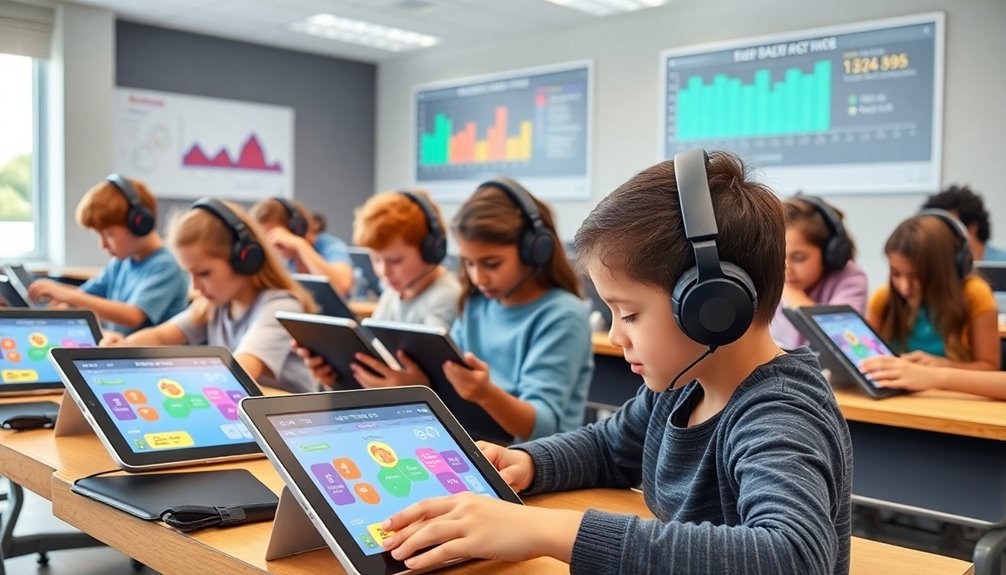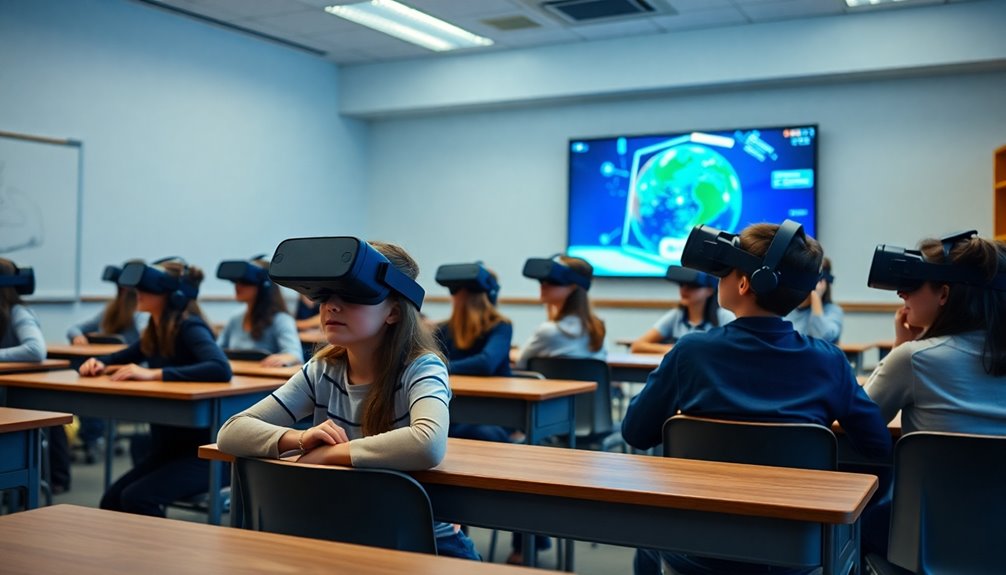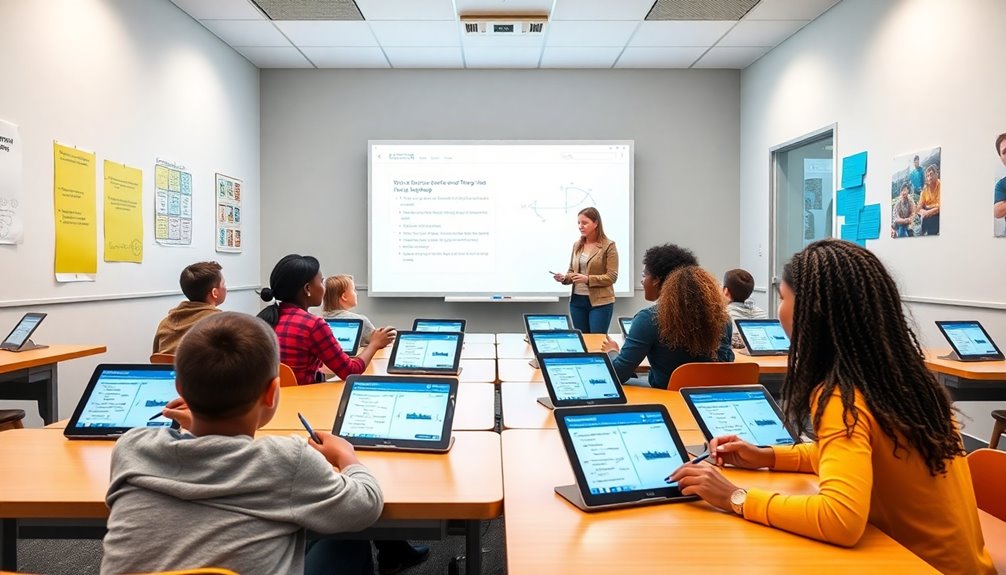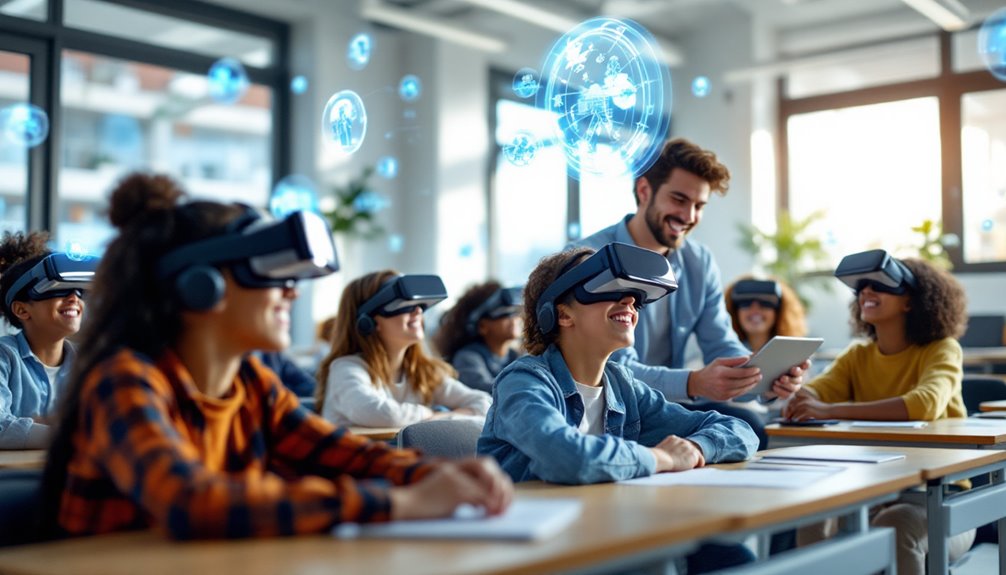You can transform education by embracing seven innovative strategies for integrating technology: personalized learning through adaptive software, gamification to boost student engagement, and immersive experiences using virtual and augmented reality. Foster collaboration through online platforms and leverage AI for personalized tutoring. Use the flipped classroom model with digital tools for dynamic learning, and offer mobile learning for on-the-go education. Discover how these strategies can reveal new ways of engaging with diverse learners.
Highlights
- Employ adaptive software for personalized learning experiences that adjust to each student's performance and needs.
- Integrate AI tutoring for 24/7 personalized assistance, offering instant feedback and customized exercises.
- Utilize gamification to enhance student engagement with points, badges, and leaderboards in a game-like learning environment.
- Implement virtual and augmented reality for immersive, interactive storytelling and 3D simulations.
- Leverage mobile learning apps for flexible, on-the-go access to educational content and analytics.
Personalized Learning Through Adaptive Software

In the rapidly evolving landscape of education technology, personalized learning through adaptive software stands out as a game changer. You're no longer confined to a one-size-fits-all approach.
With adaptive assessments, you can tailor your learning journey to fit your unique needs and pace. This innovative technology adjusts to your performance, ensuring you're always challenged but never overwhelmed.
Tailor your learning journey with adaptive assessments that adjust to your unique needs and pace.
Imagine receiving personalized feedback that's specific to your learning style, helping you identify strengths and areas for improvement efficiently. It's about maximizing your potential by leveraging technology that understands you.
As you navigate this educational revolution, embrace the power of adaptive software to transform how you learn, ensuring a more dynamic and personalized educational experience that keeps you ahead of the curve. Additionally, advanced analytics can provide insights into learner behavior, further enhancing the effectiveness of your personalized learning journey.
Gamification for Enhanced Student Engagement
Gamification can boost students' motivation by turning learning into a game-like experience. You can keep students engaged by incorporating elements like points, badges, and leaderboards, which reward their progress. This approach not only makes education more interactive but also encourages students to actively participate and aim for achievement. Additionally, implementing CRM solutions can enhance personalized learning experiences, similar to how they improve customer interactions in the food and beverage industry.
Boosting Motivation Through Games
When it comes to boosting student motivation, incorporating games into education can transform a mundane lesson into an engaging adventure.
Imagine using game design to create a classroom environment where competitive gameplay fuels learning. With achievement badges, students earn rewards for their efforts, while player feedback offers instant insights.
Narrative elements can immerse learners in story-driven quests, making skill progression an intriguing journey. Social interaction in games fosters collaboration, as students engage in cooperative missions.
Challenge levels adapt to different abilities, ensuring everyone remains engaged. Game-based learning isn't just about fun; it's about creating a dynamic educational experience.
Here's how to start:
- Design lessons with intriguing narratives.
- Use badges to recognize achievements.
- Encourage social interaction through group tasks.
- Incorporate adaptive challenge levels.
Interactive Learning With Rewards
Although traditional education methods often focus on rote memorization, integrating rewards into learning can greatly boost student engagement.
Imagine transforming your classroom into a dynamic environment where students are enthusiastic to participate. By implementing reward systems tied to interactive assessments, you can capture their interest and drive motivation. This isn't about handing out gold stars; it's about creating meaningful incentives that resonate with students' ambitions.
Through gamification, you can make learning feel like an adventure. Interactive assessments challenge students while offering immediate feedback, keeping them actively engaged.
As they progress, reward systems can acknowledge their achievements, fostering a sense of accomplishment. This approach not only enhances learning but also cultivates a culture of innovation and exploration, preparing students for future challenges in a tech-driven world.
Virtual and Augmented Reality Experiences

Why are virtual and augmented reality experiences transforming education so rapidly? These technologies offer immersive storytelling and 3D simulations that engage students like never before.
Immersive storytelling and 3D simulations are revolutionizing education by deeply engaging students.
You're no longer confined to textbooks; instead, you explore worlds and concepts in a deeply interactive manner. This approach not only enhances understanding but also ignites curiosity. Additionally, leveraging technology-driven strategies can optimize the implementation of these immersive experiences.
Here's how you can make the most of these tools:
- Dive into History: Experience events firsthand through VR, making history more tangible and memorable.
- Explore Science: Conduct experiments in a risk-free virtual lab, fostering a deeper understanding of complex concepts.
- Enhance Creativity: Use AR to overlay digital elements onto real-world settings, sparking innovative thinking.
- Improve Skills: Practice real-world applications in 3D simulations, boosting confidence and proficiency.
Embrace this new frontier!
Collaborative Learning With Online Platforms
You're probably aware that online platforms are transforming how students collaborate in education.
With virtual study groups, real-time collaboration tools, and interactive learning forums, you can connect with peers and share ideas seamlessly.
These tools make it easier than ever to engage in group work and enhance your learning experience. Additionally, integrating AI-driven workflows can streamline your educational projects and provide valuable insights.
Virtual Study Groups
As technology continues to transform education, virtual study groups have emerged as a powerful tool for enhancing collaborative learning. You can connect with classmates from anywhere, fostering dynamic group dynamics and allowing for rich peer feedback.
Virtual study groups aren't just about sharing notes; they're about building a community where innovation thrives. Here's how to make the most of them:
- Diverse Perspectives: Collaborate with peers worldwide to gain fresh insights and ideas.
- Flexibility: Schedule meetings that fit everyone's calendar, breaking geographical and temporal barriers.
- Enhanced Engagement: Utilize interactive platforms that keep everyone involved and motivated.
- Instant Feedback: Share your work and receive immediate, constructive peer feedback, refining your understanding.
Embrace virtual study groups and watch your learning experience evolve!
Real-Time Collaboration Tools
Even though online education has been around for years, real-time collaboration tools have revolutionized how we engage in learning. Imagine diving into cloud-based platforms that allow you to connect with classmates or colleagues instantly, no matter where you are.
With synchronous communication, you can brainstorm ideas, solve problems, or work on projects together in real time. These tools aren't just about convenience; they're about enhancing the educational experience by fostering a sense of community and collaboration that was once unimaginable online.
You can share documents, annotate them simultaneously, and see changes as they happen. This level of interaction can spark creativity and innovation, pushing the boundaries of traditional learning environments.
Embrace these tools, and you'll find yourself at the forefront of educational evolution.
Interactive Learning Forums
How are interactive learning forums transforming online education into a more engaging and collaborative experience?
By leveraging peer feedback and digital storytelling, these platforms foster dynamic interactions. You can share ideas, learn from others, and creatively express knowledge through stories.
Here's how to make the most out of these forums:
- Engage Actively: Participate in discussions and offer constructive peer feedback. This exchange sharpens critical thinking and expands your perspectives.
- Embrace Digital Storytelling: Use multimedia tools to narrate concepts, making learning more relatable and memorable.
- Collaborate on Projects: Work together in real-time to solve problems, creating a community of innovation.
- Reflect and Adapt: Regularly reflect on feedback received and adapt your approach for continuous improvement.
Interactive forums transform learning into an inventive journey.
Utilizing Artificial Intelligence for Tutoring
When it comes to enhancing personalized learning experiences, artificial intelligence (AI) is a game-changer in the domain of tutoring.
Imagine a tutor that's available 24/7, adapting to your unique learning style and pace. That's the magic of AI tutoring! It offers numerous benefits, like providing instant, personalized feedback that helps you understand complex concepts more effectively.
You're not limited to a one-size-fits-all approach; AI tailors the content to suit your needs.
With AI, you can dive deep into subjects with tailored exercises and interactive sessions that keep you engaged.
You'll discover gaps in your knowledge and get targeted recommendations to bridge them.
Embrace this cutting-edge technology to revolutionize your learning journey and achieve educational breakthroughs like never before. Additionally, AI can enhance the learning experience by utilizing data-driven strategies that optimize content delivery based on individual progress.
Flipped Classroom Models With Digital Tools

Why are flipped classroom models gaining traction in modern education? They empower you to foster a more engaging, personalized learning experience.
Using digital tools, you can transform traditional lectures into interactive, student-centered activities. Here's how you can innovate:
Transform lectures with digital tools into interactive, student-focused activities to innovate education.
- Teacher Training: Equip yourself with digital resources and strategies to effectively implement the flipped model. Continuous learning guarantees you're prepared for tech integration.
- Creative Content Delivery: Share videos, podcasts, and interactive modules that students can access anytime, enabling them to learn at their own pace.
- Enhanced Student Feedback: Utilize digital platforms for real-time feedback, helping you tailor your teaching approach to meet individual needs.
- Active Classroom Engagement: Use class time for discussions, projects, and problem-solving, promoting deeper understanding and collaboration.
Incorporating data-driven decision-making into your teaching strategy can further enhance the effectiveness of the flipped classroom model.
Embrace innovation and transform your teaching!
Mobile Learning for On-the-Go Education
While technology continues to evolve, mobile learning stands out as a powerful tool for on-the-go education. Imagine using mobile apps and wearable devices to learn anytime, anywhere. With offline access, you're not limited by Wi-Fi constraints. Learning analytics offer insights into your progress, while multimedia resources and cloud storage guarantee your content is always accessible. Immerse yourself in digital portfolios for tracking achievements and use social media for peer feedback and content curation. Here's how these elements compare:
| Feature | Benefit | Example |
|---|---|---|
| Mobile Apps | Learning flexibility | Khan Academy |
| Offline Access | Uninterrupted learning | Downloaded lessons |
| Learning Analytics | Insightful progress | Performance dashboards |
| Wearable Devices | Hands-free interaction | Smartwatches |
| Cloud Storage | Secure file access | Google Drive |
Leverage these tools for a transformative education journey! Additionally, incorporating automation and CRM into education can further enhance student engagement and operational efficiency.
Some Questions Answered
How Can Teachers Effectively Manage Student Data Privacy With New Technologies?
You've got to guarantee student data privacy by employing robust data encryption and effective consent management tools. Stay innovative by continuously updating your strategies to adapt to new technologies, ensuring students' information remains secure and trusted.
What Are the Cost Implications of Integrating Advanced Tech in Schools?
Imagine the potential of transforming education, yet you're worried about costs. Effective budget allocation and securing technology grants can alleviate financial burdens, ensuring advanced tech integration doesn't compromise the dream of innovative learning environments.
How Do Educators Assess the Effectiveness of Technology in Learning Outcomes?
You're evaluating tech's impact on learning by employing formative assessments and gathering technology feedback. This approach lets you pinpoint areas for improvement, ensuring students' progress aligns with innovative goals and enhancing overall educational efficiency.
What Training Do Teachers Need to Proficiently Use Educational Technology?
Isn't it coincidental how pedagogical training and technology workshops empower you to master educational tech? You're not just learning tools; you're redefining teaching. Embrace innovation, because your students' future thrives on your tech proficiency.
How Can Schools Ensure Equitable Access to Technology for All Students?
To bridge the digital divide, you should foster community partnerships that provide resources and support. Encourage innovative collaborations, ensuring every student has equal access to technology, empowering them to thrive in a connected, future-ready world.
Summing Everything Up
By embracing these innovative strategies, you'll transform education into an engaging and dynamic experience. Consider this: 74% of teachers who've adopted technology in their classrooms report increased student motivation and engagement. Imagine your students not just attending class, but enthusiastically participating and exploring new concepts with excitement. These tools don't just enhance learning—they ignite a passion for discovery. It's time to harness technology's potential and revolutionize the way education is delivered in your classroom.





